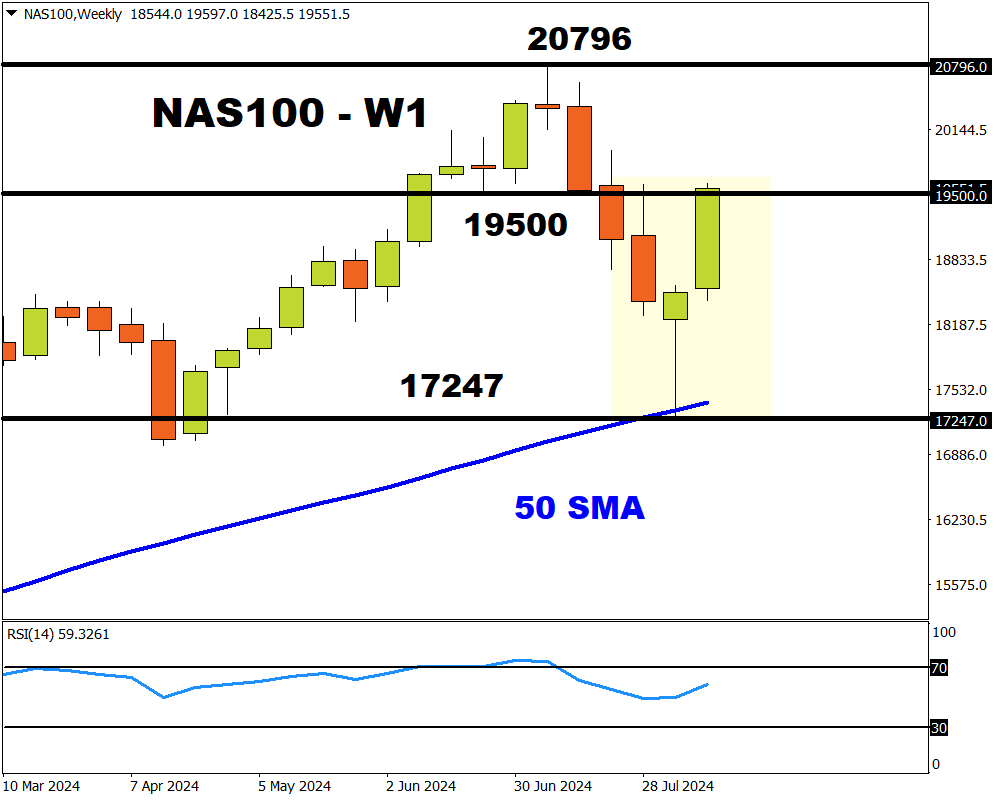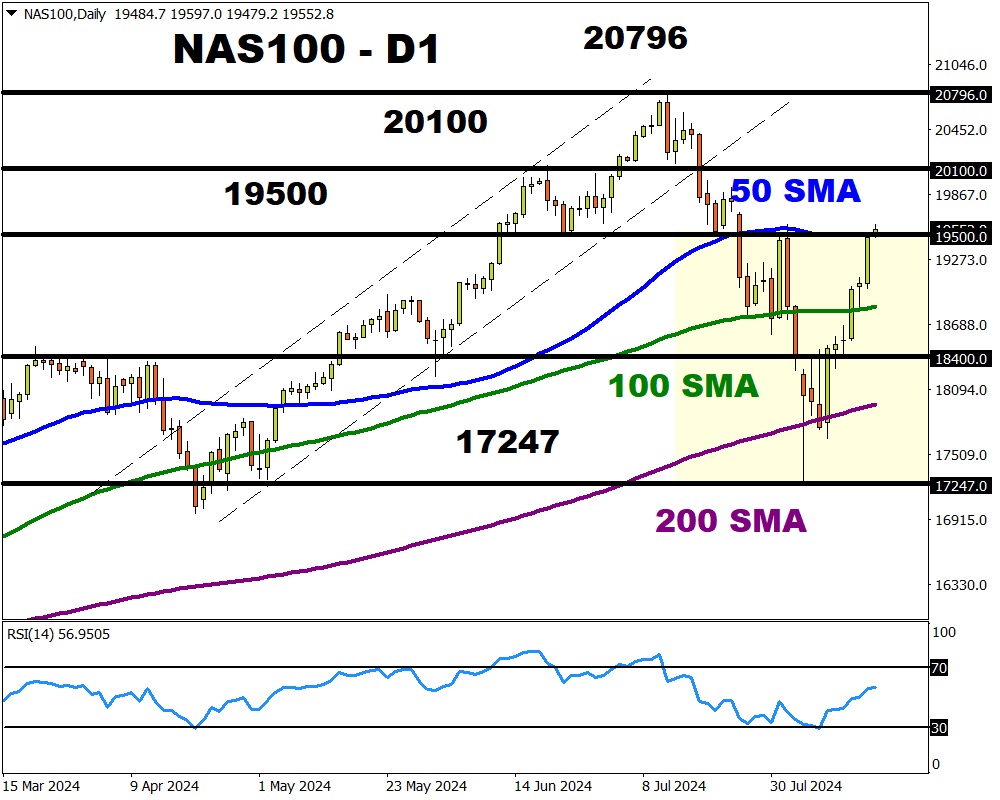- NAS100 ↑ 13% from August low
- Friday speech by Fed Powell to impact Fed cut bets
- Watch out for FOMC minutes mid-week
- Index trading roughly 7% away from all-time high
- Key levels – 18400, 19500, 20100
It’s that time of the year again with the annual Jackson Hole Economic Symposium around the corner…
But before we discuss the importance of this event, here is a breakdown of the data releases and events scheduled for the upcoming week:
Monday, 19th Aug
- JP225: Japan core machine orders
- US500: US Conference Board leading index
- US Democrat National Convention
Tuesday, 20th Aug
- CN50: China loan prime rates
- CAD: Canada CPI
- SEK: Swedish rate decision
- EU50: Eurozone CPI
- TWN: Taiwan export orders
Wednesday 21st Aug
- JP225: Japan trade
- ZAR: South Africa CPI
- NAS100: US FOMC minutes
Thursday, 22nd Aug
- EU50: Eurozone & Germany PMI, consumer confidence
- TWN: Taiwan jobless rate
- UK100: UK S&P global PMI
- US500: US initial jobless claims, S&P Global PMI
Friday, 23rd Aug
- CAD: Canada retail sales
- JP225: Japan CPI, BoJ Governor Ueda testimony
- SG20: Singapore CPI
- TWN: Taiwan industrial production
- NAS100: Fed Chair Powell speech at Jackson Hole
What is the Jackson Hole Economic Symposium?
It's an annual event organised by the Kansas City Fed in Jackson Hole, Wyoming. This year it will be held from August 22nd - August 24th.
Attendees from central bankers, finance ministers and economists congregate to discuss pressing global economic issues.
Why is it such a big deal?
Anything discussed during the symposium could trigger market volatility, especially if it has to do with monetary policy.
A trip down memory lane…
- In August 2022, Jerome Powell’s speech at the Jackson Hole symposium was firmly hawkish as he outlined plans to combat inflation. This triggered a selloff on the S&P500, resulting in a 4% decline for the week.
- Last year, Powell maintained a hawkish tilt by stating that the Fed was prepared to raise rates further if needed – citing high inflation.
What to expect this year?
It’s been a wild week for US markets with recent data soothing recession fears.
Still, Fed Chair Powell is expected to signal that a September rate cut is in the bag. But with the August jobs and inflation report published before the Fed’s September meeting, the size of the cut may remain a mystery.
Traders have currently fully priced in a 25-basis point Fed cut in September, with the probability of a 50-basis point cut at 33%.
NAS100 under the spotlight
There are a handful of assets that could rocked by Powell’s speech, but FXTM’s NAS100 has caught our attention due to its sensitivity to US interest rates.

Note: FXTM’s NAS100 tracks the underlying benchmark Nasdaq 100 index.
It has been somewhat of a rollercoaster month for the index thanks to shifting monetary policy expectations and risk appetite.
Despite the flat month-to-date gains, prices have rallied 13% from Augusts low of 17247. Bulls seem to be back in action with the index knocking on the 19500 resistances as of writing.
- FXTM’s NAS100 index could push higher if Powell strikes a dovish tone and signals that US rates will be cut in September.
- Should Powell sound less dovish than expected and provide no fresh insight into the Feds thinking, this could weigh on the NAS100.
Keep eye on the FOMC minutes
Before Powell’s big speech on Friday, the FOMC minutes mid-week may provide some insight into the Feds thinking for the rest of 2024. Should the minutes come across as dovish, this could provide support to the NAS100.
Technical forces
Prices are turning bullish on the daily charts with the NAS100 challenging the 19500-resistance level. The candlesticks are firmly above the 100 and 200-day SMA but the Relative Strength Indicator (RSI) is slowly approaching overbought territory.
- A solid weekly close above 19500 may encourage an incline toward 20100 and the all-time high at 20796.
- Should 19500 prove to be reliable resistance, this could trigger a decline to 18400, the 200-day SMA and 17247.
